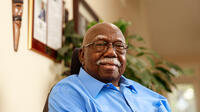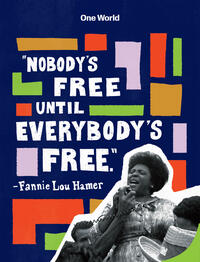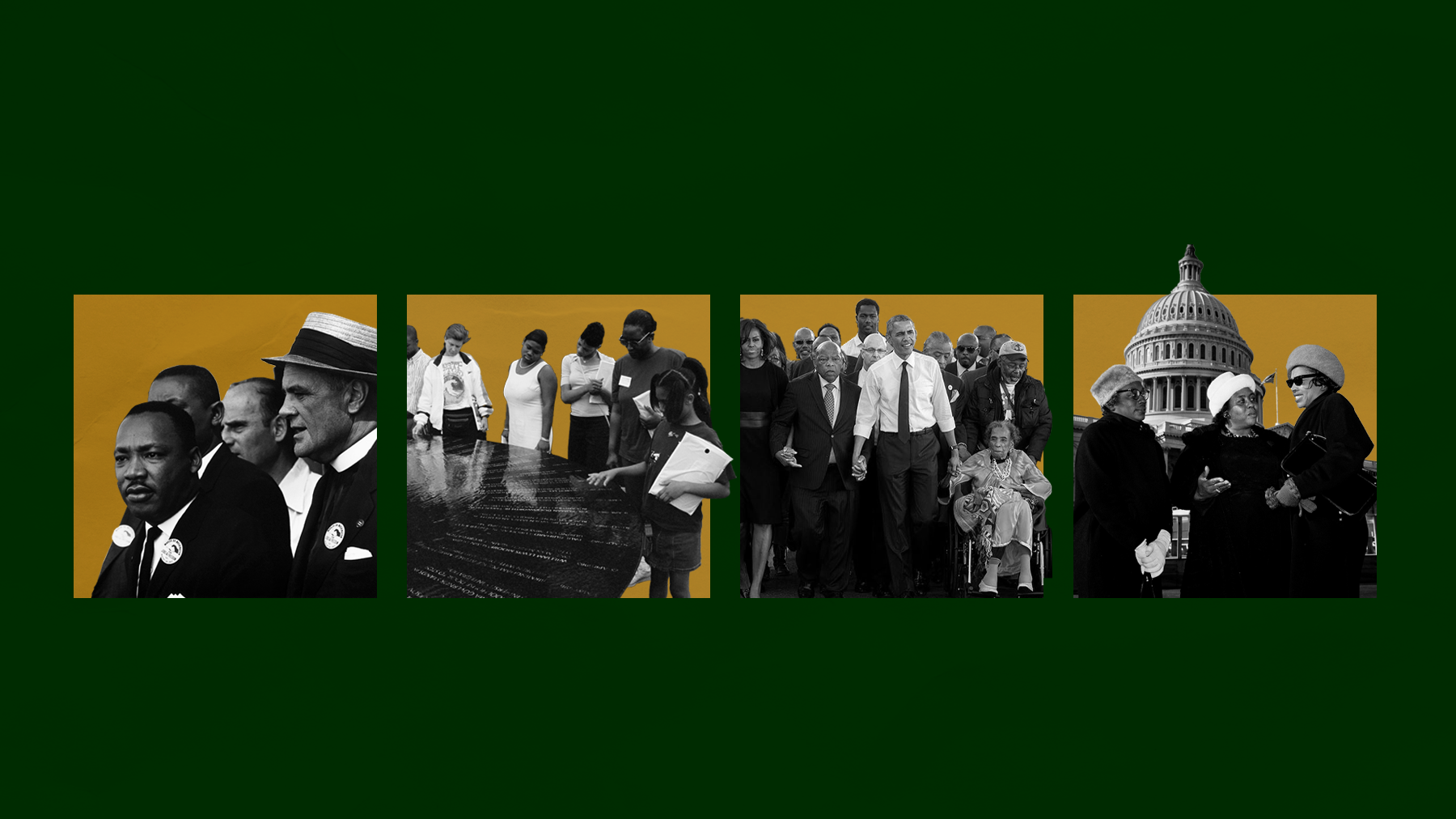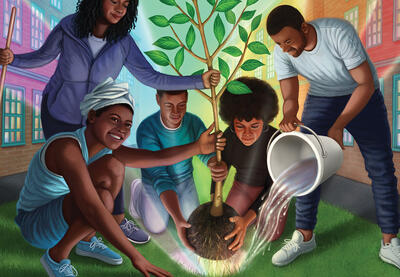Realizing one’s own capacity for action is an essential disposition for responsible citizenship. As we connect with history and understand the strategies for nonviolent direct action used during the Civil Rights Movement, we can examine today’s justice issues and find ways to answer the question: “How can we plan democratic action in our communities to effect change?”
This toolkit and learning journey facilitates an introduction to action planning and offers a structure to introduce planning action for change. The steps can be used for individual or collective planning. By understanding how to plan for direct action, individuals and groups can realize their power to effect change.

Materials & Resources
- You can download and print a workbook copy of the Action Planning Guide or use the online PDF.
- Albert Einstein Institution — On Nonviolent Action and 198 Methods of Nonviolent Action
- Video: There’s Good People Out There: A Conversation With Charles Person
- Poster: “Nobody’s free until everybody’s free”
- Action Planning — Facilitation Slide Deck (PDF) and Notes for Slide Deck
- Chart paper and markers
Facilitation Guidance
Why me? Why us? Why now?
Relationships are the core of direct action. Relationships in this space are predicated on shared commitments to the cause but can blossom into friendships. These relationships can also serve you when planning for action. Communicating who we are and our values and stories can begin to address “Why me?” “Why us?” “Why now?”
Identity and Community
This first section is a crucial step in planning because it demonstrates the importance of individual and group identity as well as relationships. As we think about the movement for justice, our identities play an important role, positioning us in particular ways to undertake this work and make a difference in our communities. Likewise, our community context is important because our communities have different needs and environments in which we are planning action. Knowing our particular community is crucial for success.
- Model an example of an identity chart. Pose the question: How do your identities position you for this work? This gets at the question of “Why me?”
- Participants will complete their own identity charts, then discuss their identities with their group.
- Whole group discussion questions to consider: Thinking about your community, who are your people? What is needed in your community? This helps us to address “Why us?” and “Why now?”
Gaining Empathy for Action
This activity helps demonstrate the importance of dialogue and communication. People often don’t listen with the intent to understand; instead, they listen with the intent to reply. This activity can help participants listen to understand others’ experiences and perspectives. It also allows us to be vulnerable with one another, thereby fostering stronger relationships. It allows us time to speak and be heard. By sharing with a partner, you make your perspectives and experiences known. This helps foster empathy and gives us another perspective to consider when we are planning our action.
- Practice communicating and active listening with a partner. Share something about yourself and why being here today is important. Consider again the questions: Why me? Why us? Why now?
- One person speaks for two minutes while the second person listens.
- Then, the listener summarizes what they heard for one minute.
- Switch roles and repeat.
How Can We Plan Nonviolent Direct Action in Our Communities to Effect Change?

Watch the short video interview There’s Good People Out There: A Conversation With Charles Person, in which Person, the youngest of the original Freedom Riders of 1961, reminds us that collective civic action is essential and so is being one of the good people out there.
- Discussion: Charles Person talks about his experiences during the Civil Rights Movement and offers some recommendations to us today. What about his words and experiences resonates with you? What actions can we take in our daily lives to become one of the “good people out there”?

Reflection: “Nobody’s free until everybody’s free.”
Fannie Lou Hamer's powerful words, “Nobody’s free until everybody’s free,” remind us that in the movement for freedom we are connected to the struggles of others. We must not only advocate for justice for issues that affect us personally, but for those that affect others in our communities and our nation.
- Think about the issues and civil rights concerns in your communities. Consider the ones that affect you personally or to which you feel strongly connected. Then think about issues that do not affect you but for which you can be an ally.
Introducing Action Planning Steps
Use the Facilitation Slide Deck to focus discussion and work during the action planning steps.
- Guide participants through the steps that are being practiced. Revise which steps to practice based on your context and time. Explain that only certain steps of the process will be practiced during the session, which also shows how the process is non-linear.
- Ask participants to share with their table at regular intervals. At the end of this stage, ask participants to share their Actionable First Step (step 10). Explain that sharing helps make the Actionable First Step more concrete by putting it out into the world.
The Next Steps: Taking Action in My Life
Questions for Reflection:
- What did you learn or realize about planning for nonviolent direct action?
- How are you feeling about your ability to take action?
Continue Learning, Reflecting and Taking Action:
- Stay connected to Learning for Justice for future days of action toolkits and resources.
- Continue to plan and implement action for positive democratic change in your community.
- Look for organizations that work to address challenges you feel are important in your community. Reach out or review their website for ways you can get involved.
Action Planning Steps
This approach to planning action is cyclical, meaning you will go through this process more than once throughout your planning and execution. You can also revisit a previous stage at any point to revise as needed. This is a tool meant to help your thinking, so be sure to use it how it works best for you.
Most importantly, know that you have more knowledge, skills and power to succeed than you realize. Take it one step at a time. You’ve got this!
Part I: Goal Setting
In the first stage, you will complete some brainstorming through freewriting. From this brainstorming, the steps will help you move toward identifying a central issue that you would like to address through action.
1. Freewrite.
On your computer or a sheet of paper, let your ideas flow in whatever way makes sense to you. It could be narrative, bullet points, abstract, anything! You can also draw, sketch, use photos – anything that helps you capture ideas about what you’d like to address in your community. Just put anything down that comes to mind during your freewriting, and feel free to add or repeat the process anytime you need to.
Use these questions to help you think about your action:
- What do you want to achieve?
- How would these changes benefit your community?
- How do the issues you are thinking about make you feel?
2. Write a one-sentence goal statement.
Reflect on your freewriting and identify a central issue you would like to address. Be as specific as possible. You can always revise later, but this will give you a strong focus for the next steps.
3. Context (the ‘What’).
Explain the issue or topic you wish to address. Describe it as though someone with no knowledge of your community will read your description.
Be detailed in how it affects the community, including any small or large groups or individuals. Does the issue have a history in the community or beyond? You may wish to do some research about it to help you develop more knowledge.
4. Rationale (the ‘Why’).
Explain why you want to address this issue in your community. You will make connections to the context and how it affects your community, but focus on discussing why the issue needs to be addressed.
What might change or improve as a result? Research may help in this section as well. For example, you may want some statistics that support your plan.
5. Action (the ‘How’).
Describe how you will address the issue you have chosen. What is the main action?
Being broad in your ideas right now is OK. You will get more detailed in the next steps. Example: Plan a day to go door to door to register people to vote or help them get an absentee ballot.
Part II: Planning
In Part II, you will begin planning how to put your idea into action. Here you will think about what questions you need answers to, who can support you and what resources you have and need. Lastly, you will begin outlining specific steps to get started.
6. What questions do you need answered?
List all that come to mind.
7. Who can help?
Create a list of contacts. These could be people you know, people that you want to meet or people in positions to help implement change.
8. Resources.
This could be things such as funding, materials, people to help and more.
- What do you have?
- What do you need?
9. Map out key steps toward the goal.
- What do you see as the steppingstones to completion? Use these big steps as waypoints.
- Break down what you need to do and list detailed steps to complete the big steps. Be as specific as possible. Remember, you’ll revise as you learn and move through your plan.
10. Actionable first step that you can do immediately.
This should be a simple task to get you started, such as contacting someone, reading policy or recruiting team members to help.
11. Seven-day plan and reflection.
Map out the next seven days. After each day, jot a couple of notes. What worked or didn’t? What did you learn? What do you need to do next based on how this step went?
Repeat this process each week.
You can also revisit previous steps anytime. Action planning is a cyclical process that often requires planning out your strategies, testing them and revising based on the outcomes.

Learning from the Civil Rights Movement
The Civil Rights Movement is a story of people who believed they could bring about change. The resources in this series can help us learn from our history and examine today’s justice issues to answer the questions: “How can I make a difference?” “How can we make a difference together?”

